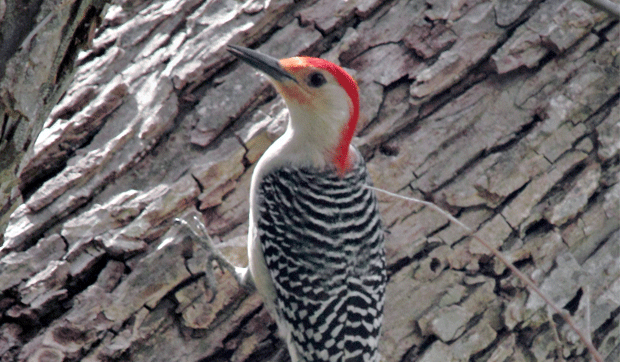Woodpecker species in our area have begun drumming, an annual sign that their breeding season has begun. The loud, staccato pounding is used to declare territory; it is distinctly different from the softer pecking sounds the birds create when excavating a nest cavity or foraging for food. Photo credit: Robert Burton, US Fish & Wildlife Service
Signs of Spring
March 10, 2017
How good are you at reading signs? Admittedly, some are easier to pick up on than others. Big red stop signs, for example, are pretty unmistakable (for most people, anyway.) Flashing neon can be hard to miss, too.
But other signs are more subtle, even though they’re all around. And right now, we’re surrounded by a bunch; they’re nature’s undeniable signs of spring. Here, in handy checklist form, are 10 of our naturalist department favorites:
- Woodpeckers, both male and female, are drumming. Listen for the rapid-fire rat-a-tat of our local species as they pound on hollow trees (and gutters) to declare territories.
- Daylight is lasting longer. Hard to believe, but we’ve added more than 100 minutes to our day length since the winter solstice back in December. Plus, we’re less than two weeks away from the spring equinox, March 20, when day and night will equal each other at 12 hours apiece.
- Canada geese are pairing off. They still prefer the safety of the flock at night, but these ever-present members of our suburban landscape have started “dating” during the day. Look for pairs feeding just ever-so-slightly away from each other in areas where that longer-lasting sun has melted the snow off the grass.
- Love is in the air. Have you smelled it? Thiols, the “active ingredient” in skunk spray, have permeated most of our neighborhoods at one time or another this season as Mephitis mephitis (Latin for Stinky stinky) goes about its courtship and mating rituals.
- Skunks aren’t the only mammals in reproductive mode. Squirrels, raccoons, opossums, foxes, coyotes…all have nearly completed their breeding activities and will soon be prepping nests and dens for the arrival of offspring.
- Male redwing blackbirds have returned. Competition is stiff among these marsh denizens, which happen to be polygynous (one male, many females) and the early birds definitely claim the better territories. They’ll defend them fiercely throughout the breeding season. (Remember this come June, when the news will no doubt include reports of redwing “attacks” on unsuspecting folks strolling too close to a well-hidden nest. Want to ward off a strike? Stare down the little stinker. RWBBs won’t fly towards eyes.)
- Spiders! Next time the sun is out, find a patch of ground where the snow has melted and leaf litter is plentiful. Bet you’ll find spiders there, tiny little guys stalking even tinier insect prey.
- Male American goldfinches are brightening. Throughout the winter months, these guys have flitted about in drab olive-yellow. But with spring just around the corner, their plumages are beginning to change. Soon they’ll be bright yellow, just as their nickname “wild canary” implies..
- Maple buds are swelling. Live near a silver maple? Those giant blobs on the ends of the branches are this year’s leaves, coiled up in buds awaiting the first rush of sap. A few more warm days and cool nights and things should really start popping.
- Skunk cabbage is up. Our earliest blooming wildflower, Symplocarpus foetidus, has popped up in wetlands throughout the TriCities. Chemical reactions allow this plant to generate temperatures 15 to 35 degrees warmer than the surrounding air. In years where we actually have snow, this reaction would help melt any flakes covering the plant. But it also serves another purpose, helping skunk cabbage spread its stinky (or fetid, as referenced in the Latin name) aroma and attract the carrion-feeding insects it requires for pollination.
I suppose I could go on and on, for more signs of spring are just around the corner. Early breeding frogs and salamanders already have made their way to breeding ponds. And soon comma, question mark and morning cloak butterflies will emerge from diapause, the insect version of hibernation.
But now my phone is ringing. And that’s a sign that it’s time to stop with this talk about signs…at least for now.

